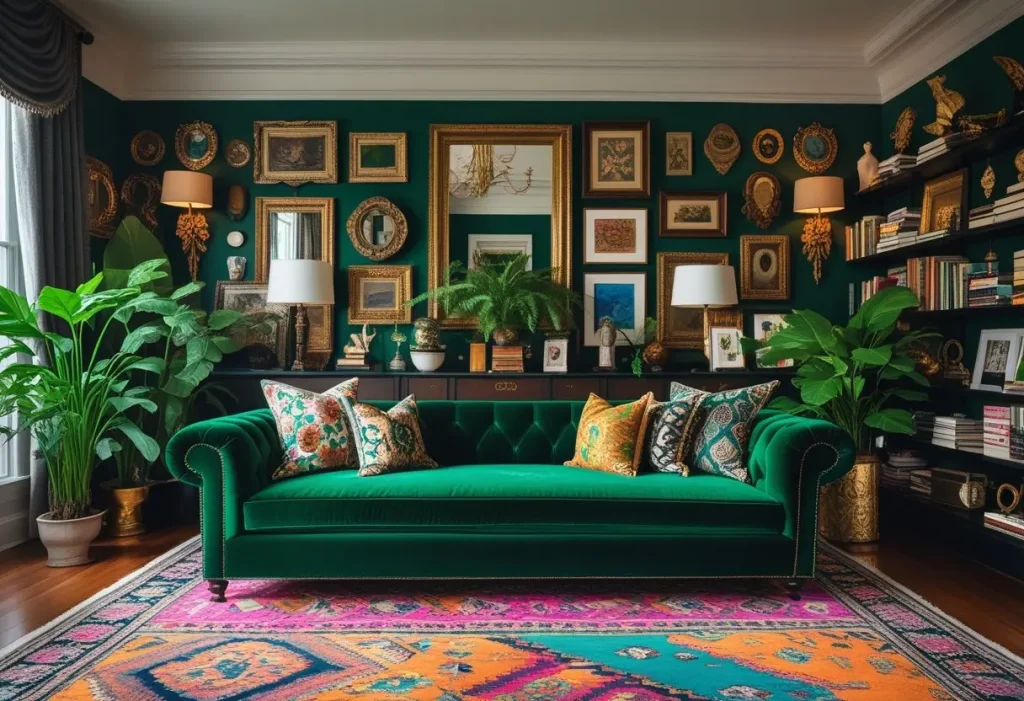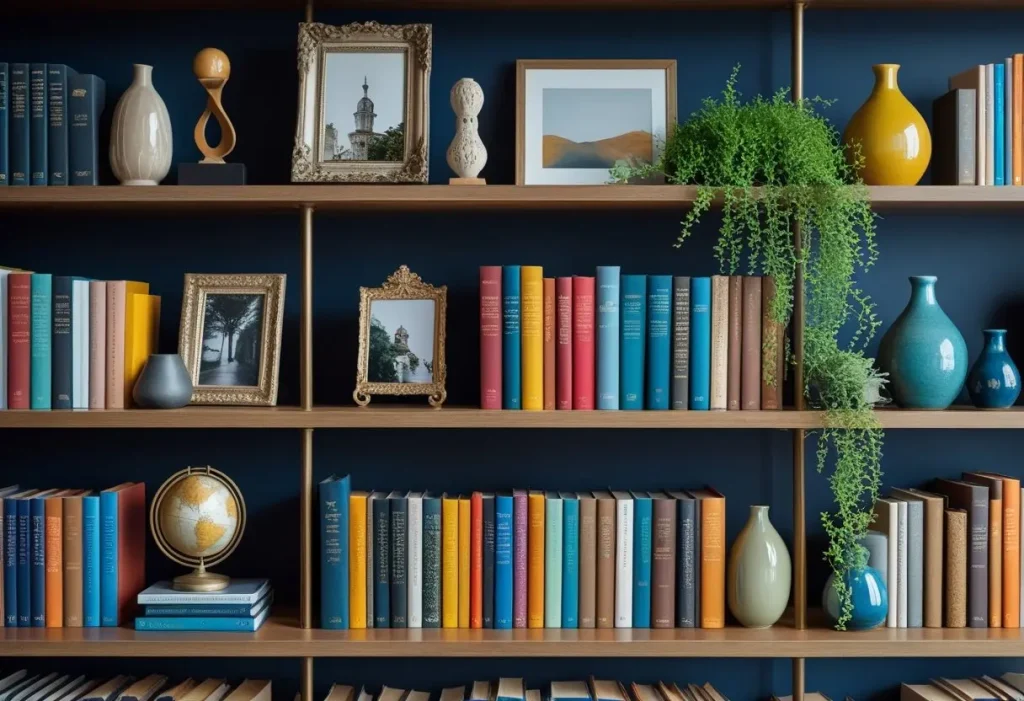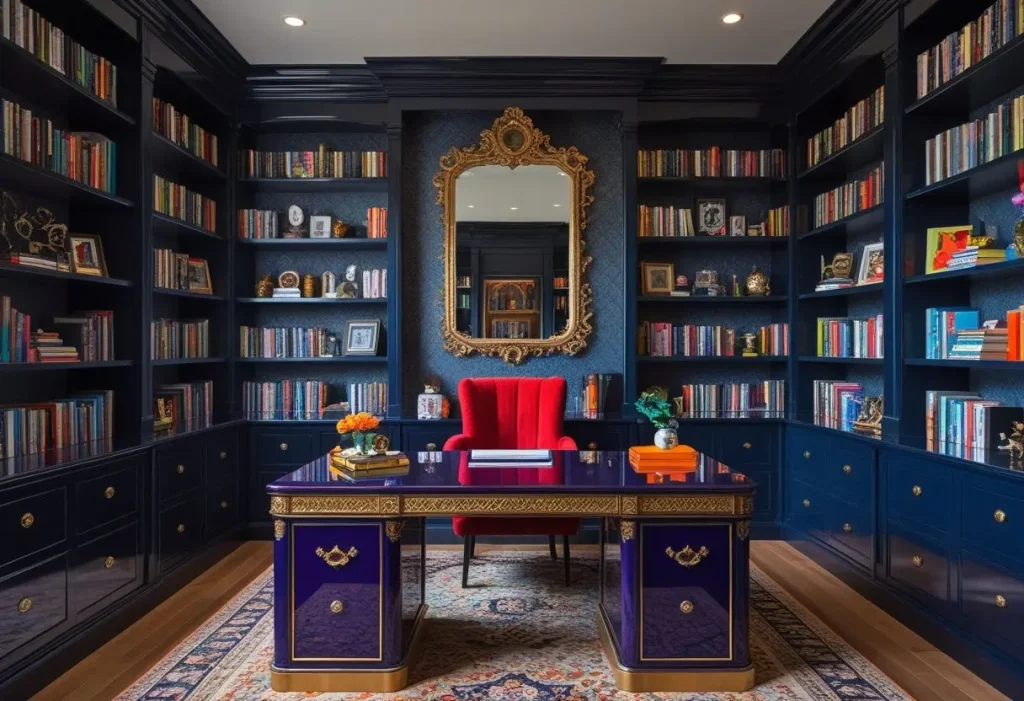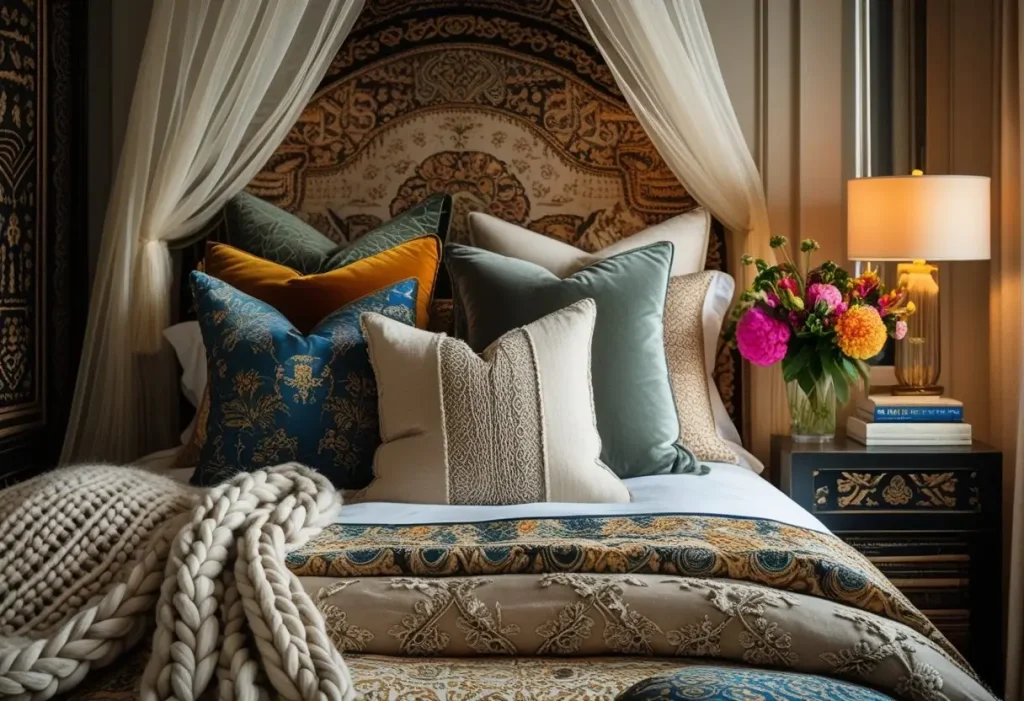Introduction: Welcome to the World of “More is More”
In a world often dominated by minimalist aesthetics—clean lines, neutral palettes, and a “less is more” philosophy—a vibrant, expressive, and unapologetically bold alternative is capturing the hearts of homeowners and designers alike: Maximalist Decor. Forget the rules of restraint; maximalism is a celebration of abundance, personality, and the art of curation. It’s not about clutter or chaos; it’s about intentional richness, layered narratives, and creating a space that is a true reflection of your passions, travels, and unique story.
If you’ve ever felt that a stark, minimalist room doesn’t quite feel like “you,” or if your heart sings at the sight of a gallery wall bursting with art, a bookshelf overflowing with well-loved novels, or a sofa adorned with a riot of patterned pillows, then maximalism might be your true design calling. This comprehensive guide will demystify maximalist interior design, providing you with the principles, inspiration, and practical steps to confidently incorporate this exhilarating style into your own home.
We will journey through the history of maximalism, break down its core principles, and provide room-by-room guides. We’ll also tackle common challenges, such as adapting maximalist decor for small spaces, and look ahead to the trending maximalist decor ideas for 2025. Our goal at CozyNestDecor.pro is to empower you to create a home that is not just stylish, but soulful. For more overarching ideas, explore our category on Home Decor Ideas.
*Brief Competitor Comparison: While sites like DecorHome.pk offer a basic introduction to maximalism, our guide is significantly more detailed, updated with 2025 trends, and structured as a professional, step-by-step masterclass. We delve deeper into historical context, provide actionable DIY tips, and include structured case studies and expert insights to ensure you have everything you need for a successful design transformation.*Maximalist Decor

H2: What is Maximalist Decor? Defining the “More is More” Philosophy
At its core, maximalist decor is an interior design style that embraces excess, eclecticism, and personal expression. It is the antithesis of minimalism. Where minimalism preaches “less is more,” maximalism joyfully declares “more is more.” This philosophy manifests in interiors filled with bold colors, contrasting patterns, a variety of textures, collected objects, and an overall sense of abundance. For inspiration, explore our Living Room Decor ideas and Small Space Decoration tips to see how you can bring the maximalist vibe into your home.Maximalist Decor
However, a common misconception is that maximalism is simply clutter or hoarding. This could not be further from the truth. Successful maximalist interior design is highly intentional and curated. Every item, color, and pattern has a purpose and a place. It’s a carefully composed symphony of visual elements, not a cacophony. The key difference lies in curation versus accumulation.Maximalist Decor
Core Tenets of Maximalist Style
- Abundance and Saturation: Spaces feel full, layered, and rich with detail.
- Personal Narrative: The home becomes a museum of the self, displaying collections, art, and objects that tell a story.
- Bold Color Palettes: Fearless use of color, often including jewel tones, saturated hues, and high-contrast combinations.
- Layered Patterns: Mixing multiple patterns (floral, stripe, animal print, geometric) in a single space through wallpaper, textiles, and art.
- Textural Variety: Incorporating a wide range of textures like velvet, silk, wool, wood, metal, and stone to create depth and tactile interest.
- Eclectic Mix: Blending furniture and accessories from different eras, styles, and cultures to create a unique, collected-over-time look.Maximalist Decor
Maximalism vs. Minimalism: A Philosophical Comparison
It’s helpful to understand maximalism in relation to its polar opposite.
| Feature | Maximalism | Minimalism |
|---|---|---|
| Philosophy | “More is More” | “Less is More” |
| Color Palette | Bold, saturated, varied | Neutral, monochromatic, muted |
| Patterns | Layered, mixed, bold | Minimal or absent |
| Space | Filled, curated, abundant | Open, sparse, airy |
| Focus | Personal expression, narrative | Function, simplicity, calm |
| Visual Impact | Energetic, stimulating, vibrant | Serene, tranquil, restrained |
Both styles are valid and beautiful; the choice depends entirely on your personality and how you want your home to feel.
A Brief History of Maximalism: From Aristocratic Opulence to Modern Eclectic
Maximalist decor is not a new trend. Its roots are deep and storied, often associated with wealth, power, and a desire to display one’s status and worldly knowledge.Maximalist Decor
The Grand Beginnings: Baroque and Rococo
The earliest precursors to modern maximalism are the Baroque (17th century) and Rococo (18th century) movements in Europe. Think of the Palace of Versailles: gilded everything, intricate detailing, dramatic frescoes on ceilings, heavy velvet drapes, and furniture dripping with ornamentation. This was maximalism as a display of absolute power and divine right. The goal was to overwhelm the senses with grandeur and opulence.Maximalist Decor
The Victorian Era: Collected Curiosities
The Victorian era (19th century) brought maximalism into the domestic sphere of the rising middle class. With the Industrial Revolution making goods more accessible, homes became filled with heavy furniture, dark colors, patterned wallpapers, and every surface covered with objets d’art, taxidermy, porcelain, and family portraits. The “cabinet of curiosities” was a peak maximalist statement, a display of one’s intellectual and worldly pursuits.Maximalist Decor
The 20th Century: From Hollywood Glam to Postmodern Play
The 1980s are often cited as a maximalist peak in recent memory. Think Memphis Milano design: bold colors, asymmetric shapes, and clashing patterns. This was a rebellious, postmodern reaction to the stark modernism of the preceding decades. Simultaneously, designers like Tony Duquette embraced a theatrical, over-the-top style that celebrated excess and craftsmanship.Maximalist Decor
21st Century Maximalism: The Age of Personal Expression
Today’s maximalist interior design is less about displaying wealth and more about displaying identity. Fueled by social media platforms like Instagram and Pinterest, people are using their homes as canvases for self-expression. It’s a global, inclusive style that mixes high and low, old and new, drawing inspiration from every corner of the world. Modern maximalism is personal, confident, and deeply authentic.
The Fundamental Principles of Maximalist Interior Design
To avoid crossing the line from “curated” to “cluttered,” it’s essential to understand the guiding principles that make maximalist spaces work.
1. The Art of Curation: Intentionality is Everything
This is the most important principle. Maximalism is not an excuse for disorganization. Every item in the room should be something you genuinely love. It’s about creating a edited collection. Ask yourself: Does this object bring me joy? Does it have a story? Does it contribute to the overall narrative of the room? Be ruthless in your editing. If something doesn’t fit or feel right, remove it.
2. Embracing Color Psychology
Color is the engine of maximalism. Don’t be afraid to use it on walls, ceilings, trim, and floors. Jewel tones (sapphire blue, emerald green, ruby red, amethyst purple) are maximalist staples because they are inherently rich and dramatic. However, a maximalist palette can also include bright neons, earthy terracottas, or deep, moody charcoals. The key is to use color confidently and consistently throughout the space.
3. Mastering Pattern Mixing
Mixing patterns can be intimidating, but it’s a skill that can be learned. The secret lies in finding a common thread.
- Color Link: Choose patterns that share at least one common color.
- Scale Variation: Combine large-scale patterns (a big floral wallpaper) with medium-scale (a geometric pillow) and small-scale patterns (a tiny ditsy print).
- Style Harmony: While eclectic is the goal, try to keep patterns within a vaguely similar “mood” (e.g., botanical themes, or geometric themes).
4. Layering Textures for Depth
Texture adds a tactile dimension that prevents a space from feeling flat. Combine smooth (lacquer, glass, silk) with rough (jute, raw wood, stone) and soft (velvet, shag rug, chenille). This creates visual weight and interest, making the room feel more inviting and lived-in.
5. Creating a Focal Point
Even in a busy room, there should be a clear focal point to anchor the eye. This could be a statement piece of furniture, a dramatic fireplace, a large piece of art, or a bold wallpaper feature wall. The focal point provides a sense of order amidst the visual excitement.

The Maximalist Color Palette: Going Bold with Hues
Color is the heartbeat of maximalist decor. Let’s explore the most effective color strategies.
Jewel Tones: The Classic Maximalist Foundation
As mentioned, jewel tones are a natural fit. They are saturated, luxurious, and create an instant feeling of opulence. Don’t just use them on accents; be brave and paint an entire room in a deep teal or a rich purple. It creates a cozy, enveloping effect.
Monochromatic Maximalism: A Sophisticated Twist
A common misconception is that maximalism requires every color of the rainbow. A monochromatic scheme can be incredibly maximalist! Choose one color and explore every possible shade, tint, and tone of it. For example, a blue room could feature navy walls, a sky blue sofa, cerulean pillows, and indigo artwork. The maximalism comes from the layering of patterns and textures within that single-color family.
High-Contrast Combinations
Black and white is a powerful, graphic base for maximalism. Use a black-and-white striped rug or a dramatic wallpaper as your foundation, then inject shots of one or two bright colors (like fuchsia or electric yellow) through accessories and art. This creates a dynamic, high-energy space.
The “Clash” that Works: Unexpected Color Pairings
Break the rules! Try pairing orange and pink, or red and purple. Often, colors that are neighbors on the color wheel (analogous) or direct opposites (complementary) can create exciting tension when used in saturated doses. Look to traditional patterns from around the world, like Moroccan tiles or Indian saris, for inspiration on color combinations that work.
H2: Room-by-Room Guide to Maximalist Decor
Now, let’s apply these principles to specific rooms in your home.
The Maximalist Living Room: The Heart of the Home
The living room is often the best place to start your maximalist journey. It’s a space for gathering, relaxing, and expressing your style.
- Start with Walls: Consider a bold, large-scale wallpaper or a deep, saturated paint color.
- Statement Sofa: Choose a sofa in a bold color or textured fabric like velvet. Don’t default to beige.
- Layer the Floor: Use a large, patterned area rug to anchor the seating area.
- Gallery Wall: This is a quintessential maximalist element. Mix frames of different styles, sizes, and finishes. Include art, photographs, mirrors, and even small shelves with objects.
- Lighting: Incorporate multiple light sources—a statement chandelier, floor lamps, table lamps—to create a warm, layered glow.
For more detailed inspiration, visit our Living Room Decor category.

The Maximalist Bedroom: A Luxurious, Personal Retreat
A maximalist bedroom should feel like a cozy, enveloping sanctuary.
- Create a Canopy Effect: Use a canopy bed or hang fabric from the ceiling to create a sense of intimacy.
- Textural Bedding: Layer your bed with a mix of patterned sheets, a textured quilt, a knitted throw, and a multitude of pillows in various sizes and fabrics.
- Dramatic Headboard: Opt for an upholstered headboard in a bold fabric or a carved wooden headboard with presence.
- Bedside Tables: Use surfaces to display curated items: stacks of books, a unique lamp, a small sculpture, and a vase of fresh flowers.
The Maximalist Dining Room: Theatrical Entertaining
Make every dinner party an event.
- Statement Lighting: A large, dramatic chandelier is a must.
- Eclectic Table Setting: Mix and match dinnerware patterns. Don’t be afraid to use different chairs around the table.
- Centerpiece Drama: Create a tall, lush floral arrangement or a collection of candlesticks as a centerpiece.
- Wall Treatment: A dramatic wallpaper or a wall of framed art makes the room feel special and enclosed.
H3: Maximalist Decor for Small Spaces: Yes, It’s Possible!
Many people believe maximalism is only for large homes. This is a myth! In fact, maximalist decor can make a small space feel incredibly cozy and intentional. The key is to go vertical and be strategic.
- Use Vertical Space: Floor-to-ceiling bookshelves or a tall, dramatic piece of art draw the eye up, making the room feel larger.
- Strategic Scaling: In a small room, choose a few larger pieces of furniture instead of many small ones, which can create visual clutter. One large sofa is better than two small chairs and a loveseat.
- Reflective Surfaces: Mirrors are your best friend. They bounce light around and create the illusion of depth.
- Cohesive Color: Using a dominant color throughout a small space can actually make it feel more expansive and less choppy.
Discover clever strategies in our Small Space Decoration guide.
Case Study: Transforming a Minimalist Apartment into a Maximalist Haven
The Challenge: A 700-square-foot apartment with a neutral, “builder-beige” palette, standard furniture, and a lack of personality. The owner felt the space was bland and uninspiring.
The Process:
- Defining a Narrative: The homeowner loved travel and vintage finds. We decided on a theme of “Global Collector” with a base palette of deep green, gold, and terracotta.
- The Bold First Step: We painted all four walls of the living room a rich, dark green. This immediately created a cozy, intimate atmosphere.
- Building the Layers:
- Furniture: We kept the main sofa (a neutral grey) but added a large, vintage Persian-style rug in reds, blues, and golds. A statement armchair in a velvet terracotta fabric was introduced.
- Textiles: We layered the sofa with pillows featuring ikat, kilim, and embroidered patterns that picked up colors from the rug.
- Art & Objects: A floor-to-ceiling gallery wall was created behind the sofa, mixing vintage maps, framed textiles, and black-and-white travel photographs. Floating shelves were installed to display collections of ceramic bowls and wooden carvings from travels.
- Lighting: A brass Moroccan-style pendant light replaced the standard ceiling fixture, and a vintage floor lamp was added in a corner.
The Result: The apartment was transformed from a generic box into a deeply personal, inspiring, and conversation-starting home. It feels twice as cozy and is a true reflection of the owner’s passions. This demonstrates that maximalist interior design is achievable at any scale.
Maximalist Decor Ideas & Trends for 2024/2025
The world of maximalism is always evolving. Here’s what’s on the horizon.
1. Grandmillennial or “Granny Chic” Revival
This trend embraces traditional, somewhat old-fashioned patterns like chintz, toile, and needlepoint, but in a fresh, ironic, and modern way. Think slipcovered sofas with ruffles, floral wallpapers, and heirloom-quality china used in daily life.
2. Dopamine Dressing for the Home
Inspired by the fashion trend, this is all about using bright, cheerful, and optimistic colors to boost your mood. Expect to see more sunny yellows, electric blues, and hot pinks used exuberantly throughout the home.
3. Dark & Moody Maximalism
A move away from bright colors towards deep, enveloping shades like charcoal, aubergine, and inky blue. This creates a sophisticated, dramatic, and cocoon-like atmosphere, perfect for bedrooms and libraries.
4. Sustainable Maximalism: The Thrifty Treasure Hunt
The ultimate form of curation is buying second-hand. This trend focuses on acquiring unique pieces from flea markets, vintage stores, and online marketplaces. It’s eco-friendly, budget-conscious, and guarantees a one-of-a-kind look.
: 5. Digital Maximalism
With the rise of the metaverse and digital art, we’re seeing influences of glitch art, pixelation, and surreal, digitally-created patterns making their way into wallpapers and textiles.

Expert Tips for Mastering Maximalist Decor
- Start Small: If you’re nervous, begin with a bookshelf, a bathroom, or a small nook. Practice curating and layering in a contained space.
- Collect Slowly: Your maximalist home doesn’t need to be built in a weekend. The best spaces evolve over years as you collect meaningful pieces.
- Edit Ruthlessly: Periodically, step back and edit your displays. Remove items that no longer serve the narrative or feel out of place.
- Look for Inspiration Everywhere: Don’t just look at interior design. Find inspiration in fashion, nature, art museums, and film.
- Hire a Professional Photographer: Once your space is complete, consider hiring a photographer. Seeing your own home through a professional lens can be a revelatory and rewarding experience.
Frequently Asked Questions (FAQs) About Maximalist Decor
Here are answers to the most common and trending questions people have about this dynamic style.
1. What is the core philosophy of maximalist decor?
The core philosophy of maximalist decor is “more is more.” It celebrates abundance, personal expression, and the intentional layering of colors, patterns, textures, and collected objects to create a space that is rich in narrative and visual interest.
2. How is maximalist decor different from just being cluttered?
The key difference is curation. Clutter is accidental and disorganized accumulation. Maximalist interior design is highly intentional. Every item is chosen deliberately and has a designated place, contributing to a cohesive, though busy, overall composition.
3. Can I have a minimalist home and still incorporate maximalist decor elements?
Absolutely! This is often called “minimalism.” You can maintain a minimalist foundation (clean lines, uncluttered surfaces) and introduce maximalist accents through a single bold feature, like a statement wallpaper in one room, a vibrant piece of art, or a collection of colorful books on a shelf.
4. What are some easy ways to start with maximalist decor if I’m a beginner?
Start with low-commitment elements:
- Create a small, curated gallery wall.
- Layer throw pillows and blankets on your sofa or bed.
- Swap out a neutral rug for a bold, patterned one.
- Style a bookshelf with books arranged by color and interspersed with objects you love.
5. What are the best color palettes for a maximalist living room?
Jewel tones (emerald, sapphire, ruby) are classic, but don’t be afraid of high-contrast black and white with pops of color, or even a sophisticated monochromatic scheme using varying shades of a single hue.
6. How do I mix patterns in maximalist decor without it looking messy?
The trick is to find a unifying element. Choose patterns that share a common color. Also, vary the scale: combine a large-scale pattern (wallpaper) with a medium-scale (curtains) and a small-scale pattern (pillows).
7. Is maximalist decor suitable for small spaces like apartments?
Yes! Maximalist decor for small spaces is very effective. Use vertical space with tall shelves and art, incorporate mirrors to create depth, and choose a cohesive color palette to make the space feel intentional and expansive rather than cramped.
8. How can I make my maximalist bedroom feel cozy and not overwhelming?
Focus on texture. Layer soft, plush textiles on the bed—velvet pillows, a chunky knit throw, silky sheets. Use warm, ambient lighting from multiple lamps instead of harsh overhead lights to create a soothing, enveloping atmosphere.
9. Where can I find unique pieces for maximalist interior design?
Thrift stores, flea markets, vintage shops, and online marketplaces (like Etsy and eBay) are treasure troves. Don’t overlook family heirlooms. The goal is to find pieces with character and history.
10. What are the trending maximalist decor ideas for 2025?
Trends include Grandmillennial style (modernized traditional patterns), “Dopamine Decor” (ultra-bright, mood-boosting colors), dark and moody palettes, and a strong emphasis on sustainable, second-hand finds.
11. How do I create a focal point in a busy maximalist room?
Even in a maximalist space, you need an anchor. This could be a statement piece of furniture (a colorful sofa), a fireplace, a large piece of art, or a dramatic light fixture. Arrange other elements to complement, not compete with, this focal point.
12. Can maximalist decor be budget-friendly?
Yes, perhaps more so than any other style! Because it’s about curation over buying expensive matched sets, you can build your room slowly over time by hunting for bargains, DIYing projects, and repurposing items you already own.
13. How important is lighting in a maximalist space?
Extremely important. Layered lighting is crucial. Combine overhead lighting (a chandelier), task lighting (table lamps for reading), and accent lighting (picture lights on art) to create depth, highlight collections, and set a warm, inviting mood.
14. How do I know when I’ve added “enough” to my maximalist decor?
This is a personal feeling. Step back and assess the room. Does it feel balanced? Can you still appreciate individual pieces, or does it just feel like visual noise? If it starts to feel stressful instead of joyful, it’s time to edit back.
15. What is the biggest mistake people make when trying maximalist decor?
The biggest mistake is forgetting about negative space. Even in maximalism, the eye needs a place to rest. This doesn’t have to be a blank wall; it can be a solid-colored area of a rug, a plain lampshade, or a simple table surface amidst the patterns.
Conclusion: Your Home, Your Story
Maximalist decor is more than just an interior design trend; it’s a permission slip to fully be yourself in your own home. It’s a rejection of generic, soulless spaces in favor of environments that pulse with life, memory, and personality. By embracing the principles of curation, color, pattern, and texture, you can transform your house into a home that is uniquely and authentically yours—a true cozy nest.
Remember, the journey to a maximalist home is a marathon, not a sprint. Collect pieces that speak to you, experiment without fear, and most importantly, have fun telling your story through your surroundings. We hope this ultimate guide has inspired you to embrace the “more is more” philosophy with confidence.
Internal Linking Suggestions (To be placed naturally within the content or as a “You Might Also Like” section at the end):
- For more on color: Link to a blog post like “How to Choose a Color Palette for Your Home” under the Home Decor Ideas category.
- For specific projects: Link to “How to Create the Perfect Gallery Wall” or “A Guide to Mixing Patterns in Textiles” in the DIY Decor category.
- For furniture: Link to “Statement Furniture Pieces for a Bold Living Room” in the Living Room Decor category.
- For small spaces: Always link back to the main Small Space Decoration category for readers living in apartments.